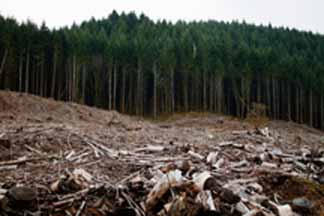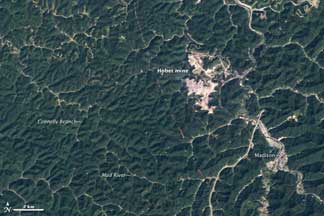How to destroy forest habitat
So if the mountain is on top of the coal, how do you get at it? Here are some ways:
- dig a mine under the surface of the ground (subsurface or underground mining)
- dig up "strips" of land, mining the new strip and putting the excess on the old strip ("strip mining")
- remove the entire top of the mountain and put it into the valley ("mountaintop removal with valley fill, or "MTR/VF")

Underground mines are both dangerous and expensive, and in many cases, especially in Appalachia, mining companies have mostly switched to surface mining. For that, you first need to get rid of the trees.
This deforestation has many effects on the ecosystem and on animal habitat:
- It gets hotter in the summer (no shade) and colder in the winter (no protection).
- Plants and animals that need shade and dense cover to live no longer have this.
- Animals that need trees for shelter (nesting birds, squirrels, insects) cannot survive there.
- Animals that consume part of the forest (nuts, leaves, insects living in trees) lose their food source
- Soil structure gets damaged and may erode more easily (because there are no roots left to hold on to it).
- Water runs off more quickly, because it is no more captured by trees, leaf litter, and roots
- Trees no longer take up carbon dioxide, adding to global warming
 |
 |
This is just a partial list of the effects of deforestation. Imagine how quickly your world would change if you lived in the area shown above -- over just 15 years!
Re-establishing a natural forest after mining operations is generally not possible. Tree seedlings have a difficult time getting established in the compacted backfill, and mining companies typically use fast-growing non-native plant to quickly establish ground cover and prevent more erosion.
Copyright University of Maryland, 2007
You may link to this site for educational purposes.
Please do not copy without permission
requests/questions/feedback email: mathbench@umd.edu